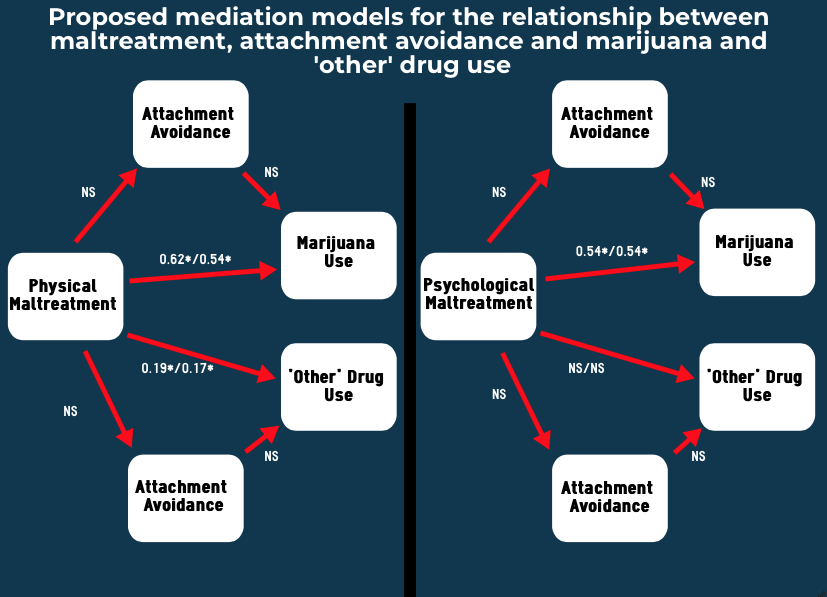Childhood maltreatment can impact adolescent risk taking behaviors. Specifically, experiencing maltreatment as a child is associated with drinking more frequently as a young adult, developing gambling disorder, and using illicit substances. In addition to childhood maltreatment, caregiver attachment style also can influence an individual’s substance use behaviors. People who are less securely attached to their caregivers are more likely to misuse substances later on. This week, STASH reviews an article by Rajan Hayre and his colleagues that looks at the impact of recent maltreatment and caregiver attachment style on adolescent substance use.
What was the research question?
Does parent-teen attachment style mediate the relationship between childhood maltreatment and adolescent substance use?
What did the researchers do?
Harye, Goulter & Moretti conducted a secondary analysis of data from a study evaluating the effectiveness of The Connect Program, an attachment-based intervention for parents and caregivers of teens facing serious mental health issues. The researchers obtained self-report data from the teenagers regarding psychological or physical maltreatment in relationships with their caregiver, their attachment style with their caregiver, and their substance use. They used mediation analyses to test if any of the four attachment styles mediated the relationship between maltreatment and substance use. In other words, if maltreatment increases the risk for substance use, does it do so by creating harmful attachment patterns?
What did they find?
Ninety percent of the youth sampled reported experiencing psychological maltreatment within the past six months, and 52% reported experiencing physical maltreatment in the past six months. In addition, 26% reported using marijuana within the past 30 days and 6% reported other drug use in the past 30 days. As expected, teens who reported psychological or physical maltreatment were more likely to report marijuana use. Moreover, teens who were relatively high in attachment insecurity1 and attachment avoidance,2 but not attachment anxiety,3 were more likely to report using marijuana and other drugs. However, the statistical tests showed that neither of these harmful attachment styles mediated the relationship between maltreatment and marijuana use.

Figure. Adapted from Harye, Goulter & Moretti (2019). For relationships between maltreatment and substance use, both total and direct effects of the relationship are shown (total/direct). * indicates statistically significant and NS indicates not statistically significant. Click image to enlarge.
Why do these findings matter?
These findings suggest that having an insecure attachment with a parent or caregiver is a separate risk factor for drug use, rather than the link in the relationship between maltreatment and drug use. It is important that parents are taught the role that their relationship with their child can have on their child’s overall well being, including substance use. Therefore, it would be beneficial to provide parents early on with information about how they can create a secure attachment with their child. One program, the Circle of Security, has already been successfully doing this through an early intervention program aimed to help parents understand how they can create secure attachment with their children.
Every study has limitations. What are the limitations of this study?
The present study only asked about maltreatment that the adolescents had experienced within the past 6 months. Though it is important to understand how recent maltreatment impacts substance use, this study failed to assess the impact of maltreatment that occurred at a younger age. In addition, the study only assessed current substance use and did not get the full picture of how maltreatment might impact substance use in the long term such as during young adulthood.
For more information:
Circle of Security has free resources for parents here. To learn more about childhood abuse and help resources, visit Child Help’s website. If you are you worried that you or someone you know has an addiction, the SAMHSA National Helpline is a free treatment and information service available 24/7. For more details about addiction, visit our Addiction Resources page.
— Alessandra Grossman
What do you think? Please use the comment link below to provide feedback on this article.
________________
[1] Attachment insecurity is an attachment pattern that results from a poor relationship with a parent or caregiver. This often occurs as a result of negative interactions or unpredictable behavior from the parent or caregiver. Insecure attachment is the alternative to secure attachment, which is a stable and healthy bond with the parent or caregiver. Individuals with attachment insecurity tend to be less trusting of others and experience greater distress, anxiety or fear especially in their relationships with others.
[2] Attachment avoidance is one type of insecure attachment pattern a child can develop with their parent or caregiver. Parents of children with this attachment style tend to ignore their child’s needs and are often emotionally unavailable. These parents will remain distant even when a child needs help the most, such as when they are hurt or sick. The child, in response to this pattern of treatment, learns not to try to seek support from their parent when they want it or need it. As a result, these children often feel that they do not need to rely on others for support because they believe that they can take care of themselves on their own.
[3] Attachment anxiety is another type of insecure attachment pattern that a child can develop with their parent or caregiver. Parents of children with this attachment style tend to be inconsistent with their behavior towards their child. Sometimes these parents will be nurturing, but other times they will be emotionally unavailable. This pattern of inconsistent parenting results in children who cling to their attachment figure because they learn that this is the best way to get the attention they desire. Later in life, individuals with this attachment pattern tend to be more insecure, heavily depend on their partners and seek others approval as a validation of their self-worth.




